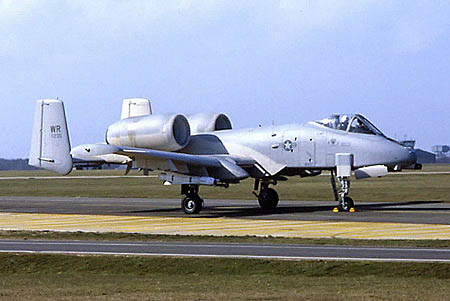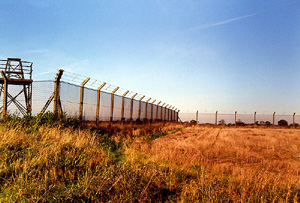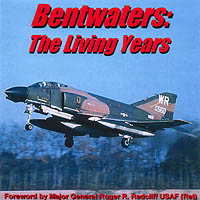Home | Airshows | The Hangar | Nostalgia | f4's F4s | Wattisham Chronicles | Links |
Bentwaters remembered
My first visit to Bentwaters was as a small boy during the late-1960s when my parents took me to one of the annual 'Armed Forces Days.' From that day on military aviation, particularly anything to do with Bentwaters, became a passion of mine. The attraction was such that, barely 12 years old, I would cycle from my home near Lowestoft along the A12 (something unthinkable on today's busy roads) and arrive at Bentwaters some three hours later. I would always head for the same place as the majority of other 'spotters' who visited the base - the area of the perimeter fence that could be reached from the road leading to Wantisden Church. This area was so popular with spotters that USAF personnel gave it the nickname 'Commie Corner.' After taking as many photographs as time allowed I would then make the return journey to arrive home before nightfall. My interest in military aviation led me to a career as a radar/navaids engineer in the Royal Air Force and, after leaving the service in 1990, I decided that I wanted to live near the base that had started it all off. My regular visits to Bentwaters continued right up until the last two A-10s were flown out, on 23rd March 1993. This was a particularly emotional day for many local residents and one that will never be forgotten.
Despite what some people have stated to the contrary, there is no doubt that the withdrawal of the United States Air Force from the Twin Bases had an impact on the local area. It has been estimated that the 13,000 service personnel and their families pumped around £1,000,000 per week into the local economy. A direct result of the loss of this input was the closure or liquidation of a number of shops and small businesses. The local economy has begun a recovery but it may never reach the height of prosperity that it attained during the 1980s and up until the withdrawal. For people moving into one of the villages around Bentwaters today, the sight of a large number of deserted and decaying buildings surrounded by a high perimeter fence will hold little, if any, interest. These people are unlikely to have any idea what role the base played during the Second World War and through the Cold War.
Air-Scene UK thoroughly recommends this excellent product which contains around 1000 photos and provides a fascinating record of what was one of the UK's busiest airfields, with unit histories, aircraft specifications and many pictures of jets from the fifties and sixties, not to mention many more obscure types. The foreword has been written by Major General Roger R. Radcliff, the 'Twin Bases' last commander. There will only be 100 copies available on a first come first served basis, so if you would like to purchase a copy of this CD at a cost of £30.00 plus postage & packing, please contact Graham at ghaynes@supanet.com.
|
 Graham Haynes
remembers a once-busy base in Suffolk
Graham Haynes
remembers a once-busy base in Suffolk Today, it is a saddening experience to
see a once pristine and busy airbase in a state of decay. To view Commie Corner from the
'other' side of the fence is a very strange experience. Bentwaters, along with several
other bases in the U.K. and Europe, was a victim of the end of the 'Cold War.' This is a
strange irony when you consider that NATO forces have seen more action in recent years
than they ever did during this period. I could write forever about my feelings for the
ongoing saga regarding the future of Bentwaters but this is neither the time or the place.
In a changing world things do go full circle and, if this is the case will there be
another Cold War? Considering the current political instability in many of the countries
that made up the former Soviet Union this is a distinct possibility. If all of the
redundant airbases are turned into housing developments or returned to agricultural land,
will there still be sufficient infrastructure available to enable to NATO's Air Forces to
expand if the need arises?
Today, it is a saddening experience to
see a once pristine and busy airbase in a state of decay. To view Commie Corner from the
'other' side of the fence is a very strange experience. Bentwaters, along with several
other bases in the U.K. and Europe, was a victim of the end of the 'Cold War.' This is a
strange irony when you consider that NATO forces have seen more action in recent years
than they ever did during this period. I could write forever about my feelings for the
ongoing saga regarding the future of Bentwaters but this is neither the time or the place.
In a changing world things do go full circle and, if this is the case will there be
another Cold War? Considering the current political instability in many of the countries
that made up the former Soviet Union this is a distinct possibility. If all of the
redundant airbases are turned into housing developments or returned to agricultural land,
will there still be sufficient infrastructure available to enable to NATO's Air Forces to
expand if the need arises?  Graham has produced this CD-ROM which aims to provide an insight
into what went on at RAF Bentwaters and RAF Woodbridge prior to the departure of the USAF.
Although the title of this work is 'Bentwaters: The Living Years,' it
would be impossible not to include Woodbridge because both bases effectively operated as
one under the control of the 81st Tactical Fighter Wing. Graham has tried to keep to
the subject matter where possible but has deemed it necessary in some instances to deviate
and include material that is indirectly associated with Bentwaters and Woodbridge. This
has been the case when writing about squadron and wing histories where he has elected to
continue these up to the present day and not end at the point at which the respective
units departed the Twin Bases.
Graham has produced this CD-ROM which aims to provide an insight
into what went on at RAF Bentwaters and RAF Woodbridge prior to the departure of the USAF.
Although the title of this work is 'Bentwaters: The Living Years,' it
would be impossible not to include Woodbridge because both bases effectively operated as
one under the control of the 81st Tactical Fighter Wing. Graham has tried to keep to
the subject matter where possible but has deemed it necessary in some instances to deviate
and include material that is indirectly associated with Bentwaters and Woodbridge. This
has been the case when writing about squadron and wing histories where he has elected to
continue these up to the present day and not end at the point at which the respective
units departed the Twin Bases.